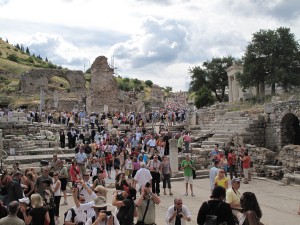Discover Ancient Thera

The main attraction of the Greek Island of Santorini is its unique landscape. The island was literally blown apart by one of the world’s largest volcanic eruptions in 1620 BC. Its picturesque villages, with their white and blue houses, drape along the hilltop overlooking the blue Aegean basin called the Caldera, the crater left by the volcano.

For lovers of ancient history, the island’s past includes an advanced sea-faring civilization with connections to the Minoans of Crete. Their town at Akrotiri, buried during the ancient volcanic disaster, was discovered in 1967 and is considered by many to be the lost city of Atlantis written about by Plato. It is often called Greece’s Pompei. It is not currently open to visitors, but many of Akrotiri’s artifacts are on display in the Archaeological Museum of Fira on the island.

But for me, when I visited Santorini this spring, the lesser known site of Ancient Thera was a very special discovery. An extensive archaeological site on top of Mesa Vouno, a ridge on the island’s southeastern side, is open to visitors and well worth the trek. 1000 feet above sea level and the town of Kamari, Ancient Thera was the island’s main town during Hellenistic and Roman times.
Ancient Thera’s ruins include a theatre, a large agora with a basilike-stoa, Roman baths, cult sanctuaries, Hellenistic and Roman houses, and the unusual temenos or sacred precinct of Artemidoros of Apollios with its rocks carvings of the eagle of Zeus, lion of Apollo, dolphin of Poseidon and his own self portrait.
For more info on Ancient Thera visit the Ancient Thera page under Graecia.
Discover Ancient Thera Read More »















